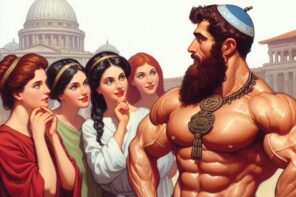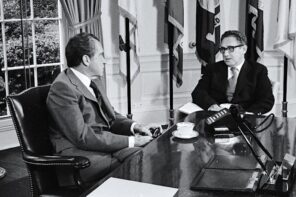Mike Huckabee won the Values Voter Summit’s presidential straw poll this weekend, comfortably outpacing both Sarah Palin and Mitt Romney. A month earlier the Fox News host and former Arkansas governor made his ninth trip to Israel. The first trip (or pilgrimage, rather) was in 1973 when, as a young Baptist minister, he was caught up in the emerging Christian Right’s enthusiasm for Israel.
Thirty-six years later, the flirtation between the Christian Right and the Israeli Right has blossomed into a long-term relationship. Evangelical Christian Zionists now call for unconditional support of the Israeli Right and its Settler Movement, even when that movement is in opposition to the policies of the Israeli government.
Huckabee’s three-day visit was spent in support of the Settler Movement’s most extreme elements, including the “hilltop youth,” young settlers who have established outposts that their own government has declared illegal. Even Prime Minister Benjamin Netanyahu, head of the Likud Party, has promised the American government that he would dismantle some of these “hilltop outposts.”
At the long-established settlement of Har Bracha, situated on a hill that looks out over the West Bank city of Nablus (Biblical Shechem), Huckabee exchanged views with one of the settlement’s leaders, Rabbi Eliezer Melamed. On hearing of Huckabee’s presidential aspirations, the Rabbi said “We hope that under Mike Huckabee’s presidency, he will be like Cyrus and push us to rebuild the Temple and bring the final redemption.” The Rabbi was referring to the Biblical account in Second Chronicles which tells of Cyrus, King of Persia and his proclamation that with the fall of Babylon the exiled Jews be allowed to return to Zion. This account, with its message of hope, serves as the closing section of the Hebrew Bible
Mike Huckabee is not the first American politician to invoke the name of Cyrus, King of Persia. In 1948, President Truman, keeping with American public opinion, granted Israel diplomatic recognition despite the protestations of many senior officials in the US State Department, Secretary of State George Marshall among them. Though historians are divided on the reasons for Truman’s decision, they are agreed that among the deciding factors was Truman’s sincere belief in the accuracy and historicity of biblical narrative and prophecy.
In 1953, only a year after he left the presidency, Truman affirmed explicitly his biblical understanding of the United States’ recognition of Israel. In a conversation at New York City’s Jewish Theological Seminary, the rabbinical school of Conservative Judaism, Truman was introduced as “the man who helped create the State of Israel.” Truman said in response. “What do you mean helped create? I am Cyrus, I am Cyrus.”
As a consequence of Cyrus’ proclamation and the subsequent ‘Return to Zion’ the Second Temple was built, standing for four centuries before its destruction at the hands of the Romans in 70 CE. Rabbi Melamed and some of his colleagues in the Settler Movement believe that they are obligated and destined to build the Third Temple, a structure that would replace the mosques on the Temple Mount (Haram al Sharif to Muslims). In the Settler rabbis’ view, “President Huckabee” would support the movement to build a Third Temple in Jerusalem. In this supposition, Rabbi Melamed is well-informed. For among Huckabee’s wealthiest and most influential supporters are ardent Christian Zionists Tim and Beverly LaHaye. Tim LaHaye, co-author of one of the greatest bestsellers in history, the Left Behind series, has endorsed Huckabee’s presidential plans. In the series’ extensive supplemental materials (videos, kids’ workbooks, theological tracts) the building of the Third Temple is a key element; for only then can the events of the End Times unfold as outlined in the book of Revelations.
As we can see from Harry Truman’s enthusiastic endorsement of the modern ‘Return to Zion,’ Christian religious beliefs have, as far back as 1948, played a significant part in US support for Israel. In the period from 1948 to the mid ’70s, when both the United States and Israel were led by governments with secular democratic agendas, the ‘Cyrus idea’ was present, if somewhat muted. The confluence of the George W. Bush presidency and a rightward shift in the Israeli government meant that visions of the Third Temple were no longer thought of as metaphorical. And although supporters of the ‘Temple Mount Faithful’ still constitute a very small percentage of Israeli Jews, their numbers are increasing rapidly.
Until recently, leaders of the organized American Jewish Community were wary of a Huckabee presidential candidacy. His 2008 description of himself as a “Christian leader” raised hackles at both the American Jewish Committee and the Anti-Defamation League. Abe Foxman, director of the ADL, wrote an open letter to Huckabee in which he stated that “we presume you seek the presidency in order to be the leader of all Americans, regardless of the faith they hold.”
But that was before the election of Barack Obama and the spread of the perception that the current administration is “anti-Israel” for, among other things, putting undue pressure on the Israeli government to freeze building activity in the Territories. As the American Jewish leadership moves to the political right—in sync with the Likud government of Benjamin Netanyahu—Huckabee may find his approval level rising. The United States’ relationship with Israel will again be a factor in the presidential election, perhaps even more so than in 2008; or as Time put it recently, this may have been Huckabee’s “first 2012 campaign stop.”




